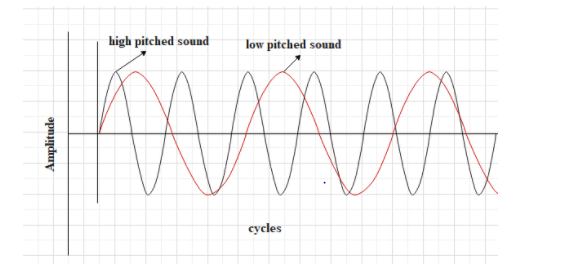
Draw a diagram to show the wave pattern of high pitch note and a low pitch note, but of the same loudness.
Answer
577.8k+ views
Hint: Define pitch and loudness of a sound wave. The pitch of the sound wave depends on the frequency of the sound wave and the loudness of the sound depends on the amplitude of the sound wave. So, we need to draw a diagram of two waves with the same amplitude but different frequency.
Complete step by step answer:
A sound wave is a longitudinal wave or a pressure wave. Longitudinal waves can be defined as the wave where the particles in the medium where the wave is propagating move parallel to or in the direction of the wave. Now, if we consider the sound wave it propagates as the particles in the medium are compressed and expanded by the vibration in the direction of propagation of the vibration. The concept is similar to the propagation of the longitudinal wave. So, we can say that the sound wave propagates as a longitudinal wave.
Now the pitch of the sound depends on the frequency of the sound. The higher is the frequency of the sound wave, the higher is the pitch note and the lower is the frequency of the sound wave, the lower is the pitch note.
The loudness of a sound depends on the amplitude of the sound wave. The more is the amplitude of the sound wave, the louder is the sound and the lower is the amplitude of the sound wave, the softer is the sound.

In the above diagram the two waves have the same amplitude and hence they both have the same loudness. But, the frequency of the two waves are different. The wave with higher frequency will have high pitch note and the frequency with lower frequency have low pitch note.
Note:
High pitch sound and the loud sound seemed to be the same. But they are two different quantities with different dependence. The pitch of the sound depends on the frequency of the sound and the loudness of a sound depends on the amplitude of the same wave.
Complete step by step answer:
A sound wave is a longitudinal wave or a pressure wave. Longitudinal waves can be defined as the wave where the particles in the medium where the wave is propagating move parallel to or in the direction of the wave. Now, if we consider the sound wave it propagates as the particles in the medium are compressed and expanded by the vibration in the direction of propagation of the vibration. The concept is similar to the propagation of the longitudinal wave. So, we can say that the sound wave propagates as a longitudinal wave.
Now the pitch of the sound depends on the frequency of the sound. The higher is the frequency of the sound wave, the higher is the pitch note and the lower is the frequency of the sound wave, the lower is the pitch note.
The loudness of a sound depends on the amplitude of the sound wave. The more is the amplitude of the sound wave, the louder is the sound and the lower is the amplitude of the sound wave, the softer is the sound.

In the above diagram the two waves have the same amplitude and hence they both have the same loudness. But, the frequency of the two waves are different. The wave with higher frequency will have high pitch note and the frequency with lower frequency have low pitch note.
Note:
High pitch sound and the loud sound seemed to be the same. But they are two different quantities with different dependence. The pitch of the sound depends on the frequency of the sound and the loudness of a sound depends on the amplitude of the same wave.
Recently Updated Pages
Master Class 11 Economics: Engaging Questions & Answers for Success

Master Class 11 English: Engaging Questions & Answers for Success

Master Class 11 Social Science: Engaging Questions & Answers for Success

Master Class 11 Biology: Engaging Questions & Answers for Success

Class 11 Question and Answer - Your Ultimate Solutions Guide

Master Class 11 Business Studies: Engaging Questions & Answers for Success

Trending doubts
10 examples of friction in our daily life

One Metric ton is equal to kg A 10000 B 1000 C 100 class 11 physics CBSE

Difference Between Prokaryotic Cells and Eukaryotic Cells

1 Quintal is equal to a 110 kg b 10 kg c 100kg d 1000 class 11 physics CBSE

State the laws of reflection of light

Explain zero factorial class 11 maths CBSE




